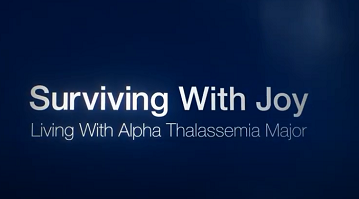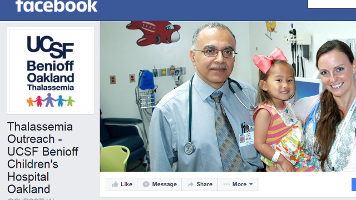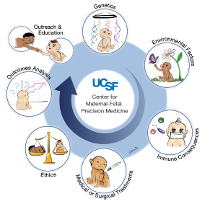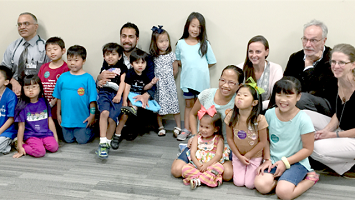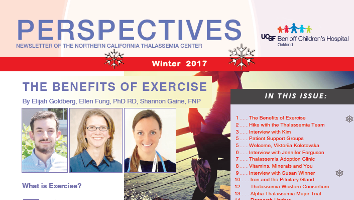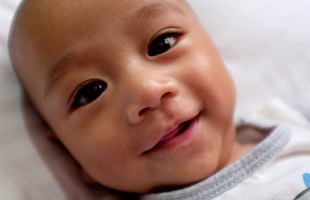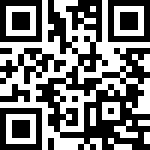HLA GENETICS
Human leukocyte antigens (HLA) are proteins that are present on the surface of our bodies' cells. Our immune system recognizes our own cells as 'self,' as opposed to 'foreign,' based on the HLA proteins displayed on the surface of our cells. HLA typing is therefore very important in order to find a donor and recipient whose cells most closely match.
In bone marrow transplantation, HLA matching helps prevent rejection as well as graft-versus-host disease (GVHD). Bone marrow is not only the source of red blood cells that carry oxygen, but also the source of white blood cells that make up our immune system. In bone marrow transplantation, the donor's immune system in effect replaces the recipient's. If there is not a good match, this new immune system may recognize the recipient's body as 'foreign' and attack various organs and tissues.
Because HLA types are genetically determined, the best chance for a match is a donor who is genetically related to the recipient. An individual's HLA type is inherited from his or her parents at the time of conception. A cluster of genes on chromosome 6 determines HLA type. Given that one chromosome 6 is inherited from the mother and one from the father, each individual carries two copies of each of the genes in the HLA cluster. There are three major genes in this cluster that seem to be particularly important in transplantation: HLA-A, HLA-B, and HLA-DR. (Other genes can also be typed and may include HLA-DQ and HLA-C.) There are many different versions, called alleles, of each HLA gene. When doctors speak of a 6-out-of-6 match, they are referring to two people matched for the same alleles at each of their two HLA-A, HLA-B, and HLA-DR genes.
Usually a full brother or sister is the best chance for an HLA match. Recall that each parent passes down only one of his/her pair of number 6 chromosomes to each child. Most people carry a different pair of alleles for the three major genes on each of their two number 6 chromosomes. Therefore, each chromosome 6 tends to carry a unique set of particular HLA alleles. So for any given couple, there are 4 possible combinations that can be inherited by each of their children. In the case of a match, each sibling inherits the same chromosome 6 from mother and the same chromosome 6 from father. Therefore, there is a 1 in 4, or 25%, chance that a sibling will be a match for a child in need of a transplant. Alternately, there is a 75% chance for a mismatch. If a related donor/recipient match us not found, a search may be requested to identify an HLA-matched donor through an unrelated bone marrow bank, such as the National Marrow Donor Program. Because there are so many different alleles for each HLA gene, the chance of finding an unrelated match is much less, although it is more common among certain ethnic groups whose HLA types show less variation.
There is another important issue related to HLA-typing of which families should be aware. Because HLA types play a role in our immune systems' responses, diseases known to have immune dysfunction as a component can be associated with certain HLA types. The reasons for these HLA/disease associations are not well understood but are well established for certain diseases. Specific HLA types have been shown to be risk factors associated with certain diseases. An example of a different type of disease-associated risk factor is high blood pressure, which is a risk factor for heart disease. In HLA-associated disease, other, non-HLA factors may play a role in the development of disease. For example, individuals that carry HLA-DR3 or HLA-DR4 allele are about 6-7 times more likely to develop insulin-dependent diabetes than people in the general population. Environmental factors (diet, certain infections) and other genes (known or uncharacterized) play a role in individuals who actually go on to develop diabetes.
There are other HLA types that are even more strongly associated with other diseases. For example, HLA-B27 carriers are approximately 150 times more likely to develop ankylosing spondylitis, a degenerative arthritic condition. Since ankylosing spondylitis is rare (about 0.14% of the population is estimated to be affected), carriers of HLA-B27 have an averaged 20% chance of developing the condition. It is important that individuals and family members who are being HLA-typed for possible bone marrow transplantation are made aware of the possibility that typing will identify the presence of a disease-predisposing type. An individual with an HLA type associated with disease susceptibility should be provided genetic counseling. A genetic counselor can provide support, explain the significance of the HLA type, assess family history and other risk factors, offer available information about prevention or medical follow-up, and discuss the implications for other family members.

